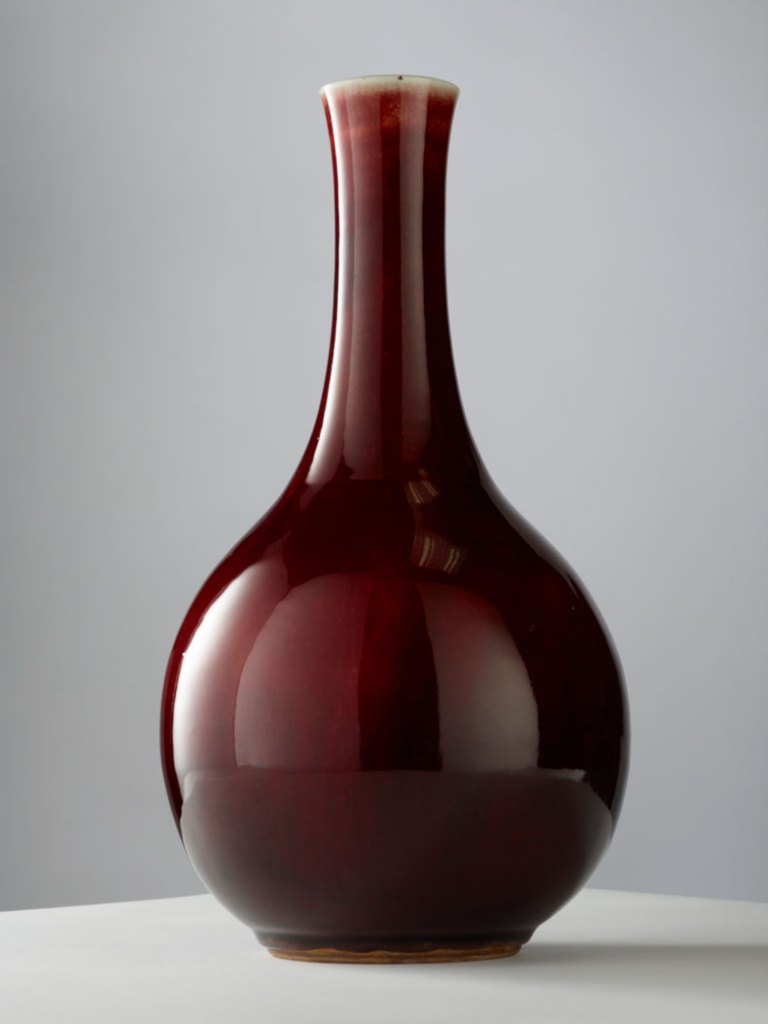From the October 2025 issue of Apollo. Preview and subscribe here.
Of all the treasures in New York’s Morgan Library and Museum, one draws me in with singular force. A deep, gleaming red, it seems at once to contain and reflect light, like a jewel. Unlike a jewel, it stands 40cm high. With a long narrow neck and wider curving body, it is a Chinese porcelain bottle vase that dates from the Kangxi reign (1662–1722) of the Qing dynasty and is now called the Morgan Ruby. Its placement on a plinth near a floor-to-ceiling window affords 360-degree views of its flawless surface and intense colour in natural light. The monochrome copper-oxide glaze, which is notoriously hard to control, has to be fired in wood-burning kilns, with reduced oxygen, at extremely high temperatures. The Chinese describe the colour as langyaohong (‘official-kiln red’); some Western experts call it oxblood (sang de boeuf).
I spent many years at the Morgan Library doing research for a biography of its founder, the banker J. Pierpont Morgan, which was published in 1999. The library is an august, intimidating place, with celebrated holdings that include ancient Babylonian cylinder seals, Egyptian papyrus rolls, Gutenberg Bibles, Old Master drawings, rare prints, letters written by Jane Austen and manuscripts by Mark Twain. During those years I never noticed the ruby vase; it had been set on a shelf against red damask walls in a dim corner of Morgan’s study, virtually invisible. It moved around as the campus went through extensive renovations in the early 21st century, ending up in storage. Not until 2016 did it secure a place in full public view, just off the glass-walled central court of the renamed Morgan Library and Museum.
In its elegant simplicity, the vase differs from most of what appealed to Morgan. Along with objects for his library, he was indefatigably acquiring Old Master paintings, tapestries, sculpture, Renaissance bronzes, watches, armour, ivories, portrait miniatures, elaborate metalwork and a great deal more. He defined the voracious eclecticism of the Gilded Age. His wife, who did not share his passion for art, once said he would buy anything from a pyramid to Mary Magdalene’s tooth. He did own a northern Italian reliquary said to contain a molar from the Magdalene’s jaw. After he died, it went to the Metropolitan Museum of Art, along with about 7,000 other items from his collections. The quality of what he purchased, even given that broad range, was extremely high. Several curators say that ‘ex-Morgan’ objects rise like cream to the tops of their collections.

Neither introspective nor articulate, Morgan never explained what he did in finance or as a collector. He was, as Henry Adams said of Theodore Roosevelt, ‘pure act’. Testifying in 1912 before a Congressional committee out to prove that he had a stranglehold on the US economy, he answered a question about why he and two colleagues had bought a life insurance company by saying simply, ‘I thought it was the thing to do.’
Although Morgan is no longer associated with Asian art, he acquired outstanding products of Chinese culture, both for himself and for the Met. He was a trustee of the museum in 1902 when the extraordinary Garland Collection of more than a thousand Chinese porcelains, which had been on loan there since 1895, was about to be withdrawn and possibly sold. Morgan bought them all for a reputed $600,000 (equivalent to around $23m today), left them at the museum and had the dealer Henry Duveen fill out incomplete sequences for another $200,000.
For his own house and library, he assembled another extensive collection of Chinese masterpieces. The ruby vase, which he purchased from a dealer in 1907, had formerly been in an imperial palace. He kept it on view near his desk in what was then his private library. A few years later, after a republican revolution in China ended nearly 4,000 years of dynastic rule, the imperial family offered, through intermediaries, to sell Morgan its entire palace collection, said to be valued at $5 million. At least one powerful Chinese republican statesman objected, and, in any case, Morgan was dying and probably never learned of this extraordinary offer.
After Morgan’s death in 1913, his son sold off many of the most important items from the collections, including the former Garland ceramics for $3.9m. Their value had quintupled in a decade, partly because of the sharp rise of Western interest in Chinese art and partly the imprimatur of Morgan’s name. Morgan junior also sold the Chinese porcelains that his father had bought for himself – all except one: the dazzling ruby vase.
From the October 2025 issue of Apollo. Preview and subscribe here.